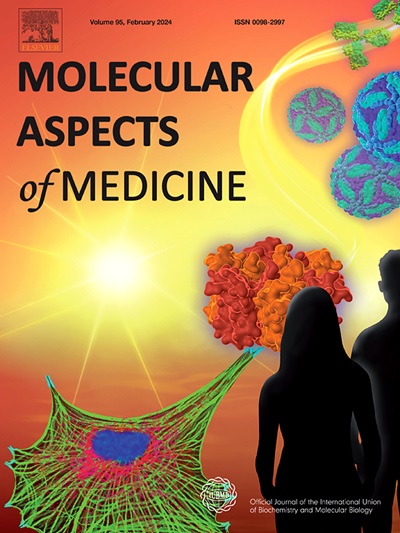揭示P2X7受体:探索其在眼部疾病中的机制、致病作用和新的治疗潜力
IF 10.3
2区 医学
Q1 BIOCHEMISTRY & MOLECULAR BIOLOGY
引用次数: 0
摘要
嘌呤能信号是由细胞外ATP (eATP)和P2受体介导的,在生理和病理过程中起着重要作用。P2X7受体(P2X7R)是一种配体门控阳离子通道,在炎症、细胞死亡和免疫反应中起着至关重要的作用。P2X7R在视网膜细胞中广泛表达,参与视觉功能调节和视网膜变性。本文综述了P2X7R与视网膜疾病的关系,包括年龄相关性黄斑变性(AMD)、behet病(BD)、糖尿病性视网膜病变(DR)、青光眼、视网膜色素变性(RP)、葡萄膜炎、Stargardt病(STGD)和弓形虫病。P2X7R激活驱动炎症、氧化应激、细胞凋亡和免疫失调。例如,它导致AMD的RPE变性、DR的血管增生、青光眼的神经炎症和RP的光感受器丧失。在葡萄膜炎中,P2X7R增强Th1和Th17的应答。用拮抗剂或调节剂靶向P2X7R具有治疗潜力,为保护视网膜功能和预防这些衰弱性疾病的视力丧失提供了策略。本文章由计算机程序翻译,如有差异,请以英文原文为准。
Unveiling the P2X7 receptor: Exploring its mechanisms, pathogenic role in ocular diseases, and emerging therapeutic potential
Purinergic signaling, mediated by extracellular ATP (eATP) and P2 receptors, plays a vital role in physiological and pathological processes. The P2X7 receptor (P2X7R), a ligand-gated cation channel, is crucial in inflammation, cell death, and immune responses. Widely expressed in retinal cells, P2X7R contributes to visual function regulation and retinal degeneration. This review explores P2X7R involvement in retinal diseases, including age-related macular degeneration (AMD), Behçet's disease (BD), diabetic retinopathy (DR), glaucoma, retinitis pigmentosa (RP), uveitis, Stargardt's disease (STGD), and toxoplasmosis.
P2X7R activation drives inflammation, oxidative stress, apoptosis, and immune dysregulation. For instance, it contributes to RPE degeneration in AMD, vascular proliferation in DR, neuroinflammation in glaucoma, and photoreceptor loss in RP. In uveitis, P2X7R enhances Th1 and Th17 responses. Targeting P2X7R with antagonists or modulators holds therapeutic potential, offering strategies to preserve retinal function and prevent vision loss in these debilitating diseases.
求助全文
通过发布文献求助,成功后即可免费获取论文全文。
去求助
来源期刊

Molecular Aspects of Medicine
医学-生化与分子生物学
CiteScore
18.20
自引率
0.00%
发文量
85
审稿时长
55 days
期刊介绍:
Molecular Aspects of Medicine is a review journal that serves as an official publication of the International Union of Biochemistry and Molecular Biology. It caters to physicians and biomedical scientists and aims to bridge the gap between these two fields. The journal encourages practicing clinical scientists to contribute by providing extended reviews on the molecular aspects of a specific medical field. These articles are written in a way that appeals to both doctors who may struggle with basic science and basic scientists who may have limited awareness of clinical practice issues. The journal covers a wide range of medical topics to showcase the molecular insights gained from basic science and highlight the challenging problems that medicine presents to the scientific community.
 求助内容:
求助内容: 应助结果提醒方式:
应助结果提醒方式:


